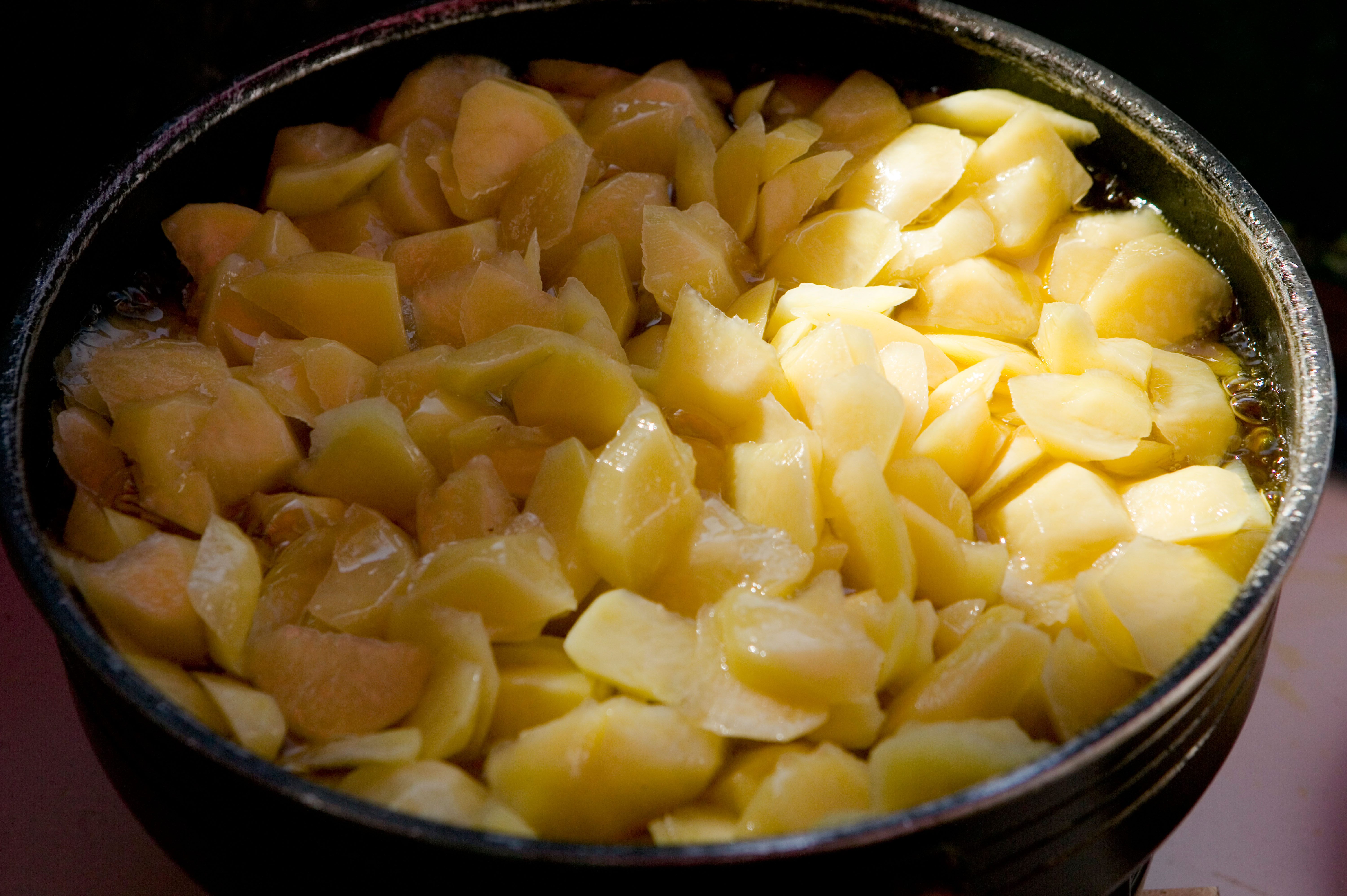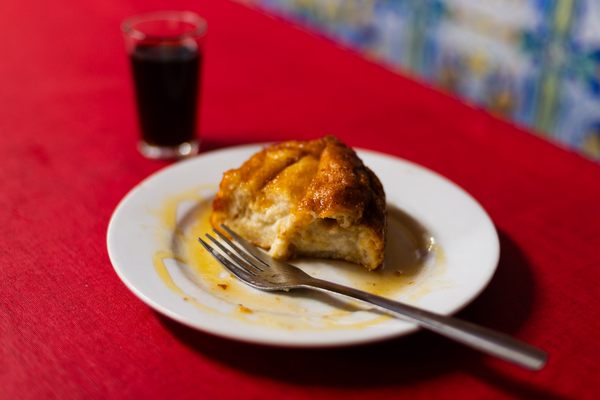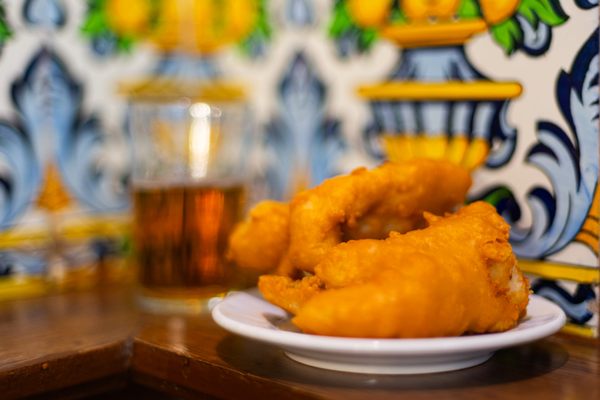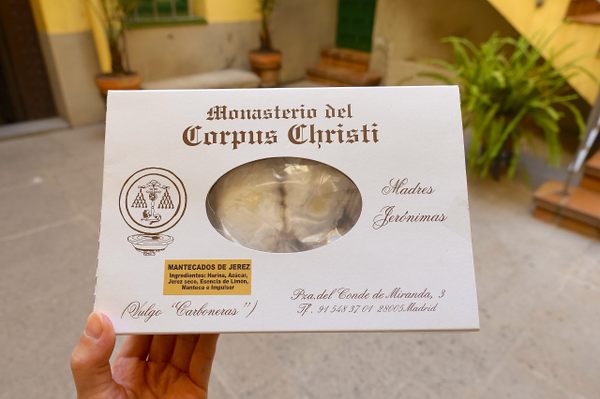A 20,000-Euro Monument to the Spanish Tortilla
One town is staking a claim.

Come May 2018, a small plaza in the small city of Villanueva de la Serena, Spain, will echo with the sound of mixing concrete and masonry tools. Workers will not be repairing infrastructure or constructing a new building, but rather erecting a large piece of art celebrating Villanueva’s unique and delicious claim to fame. Historical research has determined that the tortilla de patatas, one of Spain’s most legendary and culturally important foods, originated in Villanueva, and the construction project scheduled for next spring will be a €20,000 monument to the dish.
The tortilla, which resembles a dense quiche and is served in triangular slices called pinchos, will be memorialized in Villanueva via a giant concrete slice, from which a metal fork will extend fifteen feet into the air. Emi Villar Lozano, the local government’s Deputy Head of Cultural Affairs, says she hopes to have the monument done in time to be inaugurated at the city’s 2018 tortilla festival, which packs Villanueva’s maze-like streets for three days each June. Local sculptor Antonio Ramos Calderon will be paid €3,000 for his design, one of the many accolades he’s received during his artistic career.
“I didn’t betray my artistic sensibilities [in creating the monument],” Calderon says. “I wanted to do something more classically artistic yet contemporary. The fork will look like a drawing made in the air.”
Calderon’s design was the winner of a 2017 contest hosted by Villanueva’s government, designed to “promote and spread the Villanuevan origin of the tortilla.” Entries came in from all over the Iberian Peninsula, and in a fitting outcome, the judges selected a local artist’s entry in a blind selection process. Calderon previously completed a monument to the Villanuevan who conquered what would become Chile, and said he is honored to memorialize a part of Spanish culture that doesn’t have so much historical baggage. The surreal and elegant sculpture will help cement—literally—Villanueva’s cultural importance.

“The tortilla is said to have come from all over Spain, but we have it documented!” Lozano says. “Now everyone associates it with Villanueva, and we’re just making it official.” Villanueva de la Serena is a town of around 26,000 people located in Extremadura, an agricultural state in southwestern Spain. Villanueva was founded in the 13th century and has all the accoutrements of a traditional Iberian village: fountains, cathedrals, a central plaza, and narrow stone streets.
The tortilla is everywhere in Spain—any establishment that serves food has the tortilla as one of its staples. A finished tortilla is a little smaller than a dinner plate and is almost always comprised of only four ingredients: potatoes, olive oil, eggs, and salt. (Onions are the most common exception to this rule.) To make a tortilla, the potatoes are cut thin and softened in hot oil before being tossed with beaten eggs. This mixture is fried in oil on both sides, and the heat solidifies everything into a crust-less potato pie. When it is done right, a good tortilla is simultaneously light and filling, a comfort food that is the perfect accompaniment to everything from espresso to gazpacho to jamón serrano.
Given the ubiquity of a food like the tortilla, which in Extremadura is pronounced “tor-tee-jzhah,” it seems like it would be hard for a gastronomical historian to track down its origins. Towns across Spain boast plausible legends about one of their chefs first preparing it, but a government historian named Javier López Linage traced the tortilla to Villanueva.

López Linage uncovered what is so far the earliest mention of the dish, a recipe penned on February 27, 1798, by Villanueva landowners Marquis of Robledo and Joseph de Tena Godoy y Malfoy, who were looking for a filling but inexpensive way to feed their serfs. They worked alongside local cooks and perfected the potato and egg mix into a tortilla that resembled the tortillas of today. And from Villanueva, the tortilla spread. “The tortilla is one of the most democratic foods in Spain,” Calderon says. “People from all strata of society enjoy it as a national tradition.” López Linage said that the tortilla creates “more cohesion in Spain than the constitution.”
But the potato is not native to the country. As Redcliffe N. Salaman explains in The History and Social Influence of the Potato, the tuber originated in South America and was grown there for thousands of years. The Spanish conquistadors encountered hundreds of varieties of potatoes as they marauded across the continent, and they recorded their impressions of the strange food.
Pedro de la Cienza de Leon wrote in 1538 that potatoes were like truffles but with less-firm skin, and produced a pulp like roasted chestnuts when cooked. Another chronicler wrote that the potato helped people of the highlands of Peru live well past the age of 100, while others contended that it likely caused leprosy. More than one scribe noted that the potato causes serious flatulence, while Gaspar Bouhin wrote in 1619 that potatoes “excite Venus and augment the semen.” In any case, they sent samples home, and the tuber’s first appearance in Spain is pegged at around 1570.

The potato was initially considered a luxury because it was difficult to adapt to the Spanish climate, and nobody quite knew what to do with it. But cultivation was widespread by the late 17th century, and the potato is credited with ameliorating widespread hunger at the time. As López Linage noted, the Spanish tortilla was developed for the same reason. (The Villanuevans were hardly the first to put these ingredients together—people in South America had been doing this for generations—but the tortilla was a novel creation in Spain.)
According to Emi Lozano, the tortilla ranks with flamenco and paella in giving Spain its international renown, which is why Villanueva’s government jumped at the chance to tout its relationship to the food. Spain is in the midst of an ongoing economic crisis, and thus the idea of spending €20,000 on a sculpture was met with some disapproval. (Villanueva’s unemployment rate is around 10 percent.) But Lozano says that more or less the whole community is behind the idea to build it. In fact, she says, some of the biggest disagreements were over the design itself. Calderon’s design “wasn’t my favorite,” she says, laughing, but she’s pleased the winner ended up being from town.
Food origin stories are notoriously hard to track down—an earlier recipe could surface somewhere in the archives of another small town. But in a testament to people’s desire to link themselves to food history, Villanueva is already committed to staking its claim to the tortilla. During Villanueva’s annual tortilla festival in 2015, chefs set a record for the world’s largest tortilla de patatas by cooking one up with 3,700 eggs, 2,500 pounds of potatoes, 50 liters of oil, and 17 pounds of salt. That giant tortilla was sliced into 3,500 servings, and a giant tortilla monument will soon preside over the creation of future gargantuan tortillas at Villanueva’s festivals.
Calderon’s monument design doubles as a bench, and this is a feature that pleases Lozano. Visitors and townspeople can sit and reflect on the tortilla’s history and the small town where it got its start.
“The bench is the base of the sculpture, and the tortilla is the base of our culture,” she says. “The tortilla is going to be associated with Villanueva de la Serena forever.”
Gastro Obscura covers the world’s most wondrous food and drink.
Sign up for our email, delivered twice a week.



































Follow us on Twitter to get the latest on the world's hidden wonders.
Like us on Facebook to get the latest on the world's hidden wonders.
Follow us on Twitter Like us on Facebook